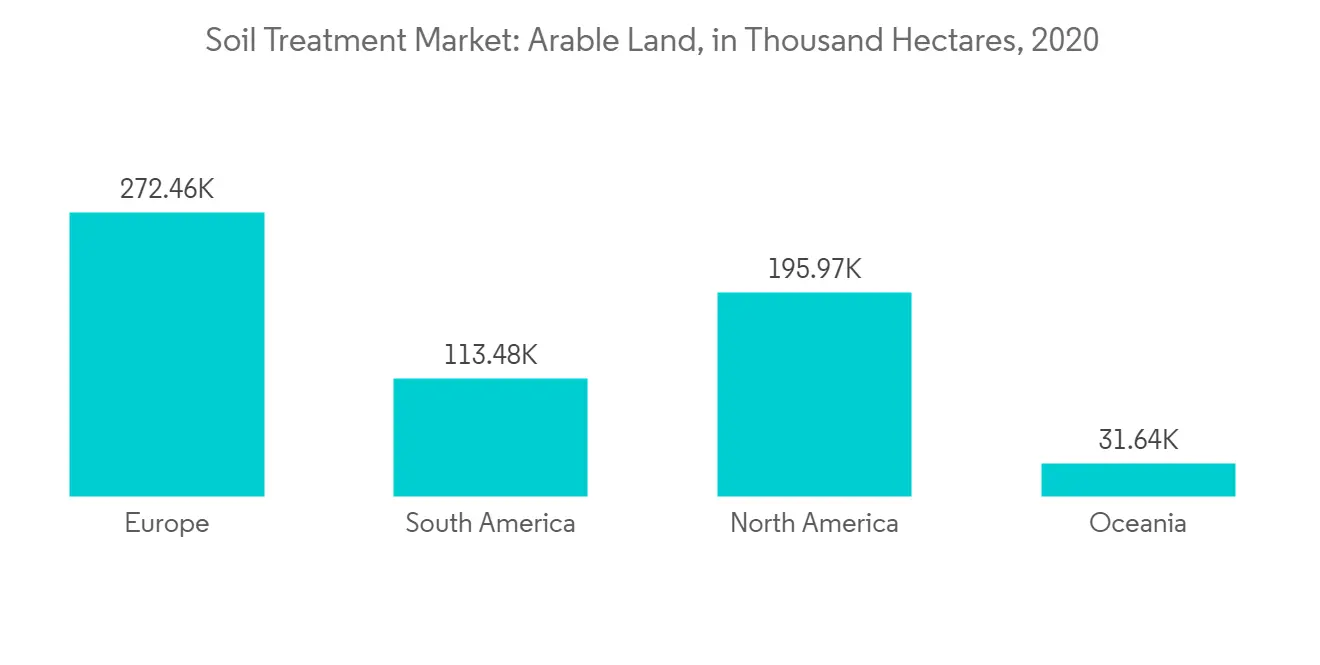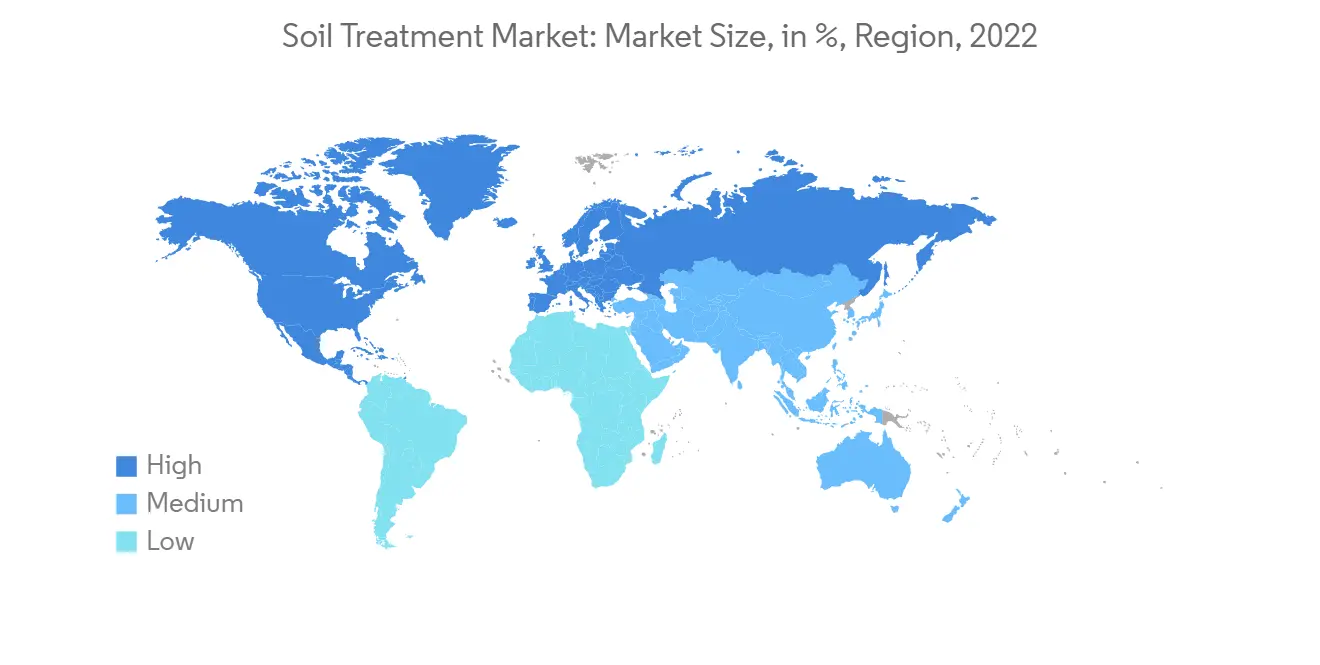 |
市場調查報告書
商品編碼
1326322
土壤處理市場規模和份額分析 - 增長趨勢和預測(2023-2028)Soil Treatment Market Size & Share Analysis - Growth Trends & Forecasts (2023 - 2028) |
||||||
※ 本網頁內容可能與最新版本有所差異。詳細情況請與我們聯繫。
土壤處理市場規模預計將從2023年的418.9億美元增長到2028年的547.8億美元,預測期內(2023-2028年)複合年增長率為5.51%。
主要亮點
- 土壤處理用於使受污染的土壤可用於農業或其他用途。有助於改善土壤性能和肥力。生物處理或生物修復廣泛用於利用細菌分解土壤中的物質來修復土壤中的有機成分,例如燃料和油。
- 生物處理經濟但耗時,需要一到幾個月的時間來實施。生物修復的適用性取決於污染物、場地條件和目標水平。由於其生態友好的特點,利用微生物過程修復污染土壤已被證明是有效和可靠的,並且該領域可能在未來幾年進一步發展。
- 儘管熱處理可以快速可靠地修復受污染的土壤,但由於其能源密集型性質和破壞土壤特性的可能性,它被認為是不可持續的。此外,該工藝相對昂貴,因此該細分市場的市場份額較小。中國政府計劃到2020年將90%的污染農用地轉化為安全農用地。因此,政府認真調查了該國的土壤污染情況,這也是這一時期土壤處理行業增長的推動力。
- 2021年4月,美國農業部(USDA)國家糧食和農業研究所(NIFA)宣布了幾項重大計劃,幫助農民管理氣候變化對其田地和生產的影響,我們已投資約2170萬美元。NIFA 還通過農業和食品研究計劃 (AFRI) 向 14 項土壤健康撥款投資 630 萬美元,向 7 項土壤信號撥款撥款 540 萬美元。
土壤處理市場趨勢
人均耕地面積減少,糧食需求增加
- 據聯合國預計,到2022年11月中旬,世界人口將達到80億,並在未來30年增加近20億,從2022年的80億增至2050年的97億。隨著人口數量的增加,未來幾年糧食需求預計將增加一倍。養活不斷增長的人口是一個令人擔憂的問題。另一方面,工業化和城市化正在減少農業大國的耕地面積。
- 聯合國糧食及農業組織(FAO)發布的2050年資源預測顯示,全球僅有12%的土地用於農作物生產,農業用地進一步擴張的空間已所剩無幾。因此,現有耕地面臨著使用土壤處理產品生產更多糧食的壓力。
- 據聯合國糧農組織統計,北美、歐洲、南亞等發達國家耕地面積減少了5400萬公頃。研究預計,耕地面積下降速度將更慢,到2030年將減少至6.08億公頃,2050年將減少至5.86億公頃。
- 適當和平衡地使用土壤處理產品可以讓我們利用現有的耕地來養活不斷增長的人口。
- 除了農業用地減少之外,微量營養素缺乏症在世界範圍內也很普遍,亞太地區是受這種缺乏症影響的主要地區之一。超過一半的穀類作物土壤缺鋅,約三分之一的耕地土壤缺鐵。據估計,40-55% 的土壤中度缺乏鋅,25-35% 的土壤中度缺乏硼,約 10-15% 的土壤中度缺乏其他微量營養素。由於土壤中微量營養素大量缺乏,農作物對化肥和農藥沒有反應,導致產量下降。這個問題可以通過使用 pH 調節器來解決。

北美主導市場
- 在美國、加拿大、墨西哥等北美國家,人們對土壤污染和修復的擔憂日益增加,從而引發了農業土壤處理。土壤是生態系統的重要組成部分,提供廣泛的生態系統服務,支持人類福祉和自然系統。土壤是農業生產的基礎,為農作物提供養分和水,並支持提供食物、纖維和燃料的植物生長。
- 土壤在水和養分循環中也發揮著重要作用,充當水和污染物過濾器、調節水流並防止侵蝕。美國農業部 (USDA) 制定了一項指令,規定了 2020 年土壤和土壤相關材料的進口和國內運輸的植物檢疫要求。這包括對土壤和受土壤污染的物品的要求,例如原木和木材、車輛、設備、工具和容器。
- 根據加拿大食品檢驗局 (CFIA) 的說法,加拿大的土壤非常肥沃且複雜,幾乎不可能使其免受這些害蟲的侵害。因此,需要採取嚴格的土壤植物檢疫措施,以減少重要土傳檢疫性害蟲傳入和傳播到加拿大的風險。2021年,加拿大政府將在未來五年內向加拿大食品檢驗局(CFIA)投資1.626億美元,每年投資4000萬美元,以維護加拿大食品安全體系的完整性,提高食品供應的質量。支持加拿大公司的進出口活動,以保護動植物健康,克服水土流失和全球貿易不穩定。因此,國內對土壤處理有足夠的認識,這正在推動該國的市場。
- 在墨西哥,土壤修復受《廢物預防和管理法》(LPMW) 的監管,該法規定了當土壤受到危險化學品污染時預防或減少迫在眉睫的健康和環境風險的措施,並需要立即採取清理措施。這些法律建議在國內使用土壤處理產品。
- 墨西哥農藥引起的土壤污染是一個嚴重的問題,各個研究小組正在開發生物策略來評估農藥的生物降解性,以及生物減毒方法來處理、修復和使受農藥污染的場地變得無害。我們正在開發生物刺激、生物強化和生物強化堆肥方法。這表明日本的土壤處理市場正在迅速擴大。

土壤處理行業概述
研究的市場高度分散,大量公司佔據市場份額。然而,Bayer Crop Science AG、Corteva AgriScience、BASF SE、Syngenta、AMVAC Chemical Corporation等公司正在努力增加其市場份額。在全球土壤處理市場中,企業正在將戰略併購和業務擴張作為關鍵戰略,同時推出創新產品。除了創新和擴張之外,研發投資和新產品組合的開發也將成為未來幾年的關鍵戰略。
其他福利:
- Excel 格式的市場預測 (ME) 表
- 3 個月的分析師支持
目錄
第 1 章 簡介
- 研究假設和市場定義
- 調查範圍
第二章研究方法論
第三章執行摘要
第四章市場動態
- 市場概況
- 市場驅動力
- 市場製約因素
- 波特五力分析
- 供應商的議價能力
- 買家和消費者的議價能力
- 新進入者的威脅
- 替代品的威脅
- 競爭公司之間敵對關係的強度
第五章市場細分
- 技術領域
- 理化處理
- 生物處理
- 熱處理
- 類型
- 有機添加劑
- pH調節劑
- 土壤保護
- 區域
- 北美
- 美國
- 加拿大
- 墨西哥
- 其他北美
- 歐洲
- 西班牙
- 英國
- 法國
- 德國
- 意大利
- 歐洲其他地區
- 亞太地區
- 中國
- 日本
- 印度
- 澳大利亞
- 韓國
- 亞太其他地區
- 南美洲
- 巴西
- 阿根廷
- 其他南美洲
- 非洲
- 埃及
- 南非
- 其他非洲
- 北美
第六章 競爭狀況
- 最常用的競爭對手策略
- 市場份額分析
- 公司簡介
- Bayer CropScience AG
- American Vanguard Corporation
- Syngenta
- BASF SE
- Novozymes AS
- Soil works LLC
- DOWA ECO-SYSTEM Co. Ltd
- Isagro SpA
- ADAMA Ltd(Makhteshim Agan Group)
- Southern Petrochemical Industries Corporation(SPIC)Limited
- SA Lime & Gypsum
- Soil Technologies Corp.
- SWAROOP AGROCHEMICAL INDUSTRIES
- SAINT GOBAIN
- Rallis India Limited
- Ohp Inc.
- Agro phos india limited
- Terracottem Australasia Pty Ltd
- Terramanus Technologies LLC
- KANESHO SOIL TREATMENT SRL/BV
- Platform Specialty Products
- Sardar Bio Chem
- International Rehabilitation and Soil Stabilization Services(IRASSS)
- UPL Limited
- Corteva Agriscience
第七章市場機會與未來趨勢
The Soil Treatment Market size is expected to grow from USD 41.89 billion in 2023 to USD 54.78 billion by 2028, at a CAGR of 5.51% during the forecast period (2023-2028).
Key Highlights
- Soil treatment can be used to make contaminated soil usable for agriculture and other purposes. It helps enhance the performance and fertility of the soil. Biological treatment or bioremediation is widely used to remediate soil from organic components like fuel or oils using bacteria to break down the substances in the soil.
- Although biological treatment is economical, it is time-consuming and takes as long as 1 to several months to be carried out. The suitability of bioremediation depends on the contaminants, site conditions, and target levels. Remediation of polluted soil using microbial processes has proven effective and reliable due to its eco-friendly features, and the segment is likely to grow further in the coming years.
- Thermal treatment can remediate contaminated soil rapidly and reliably, but its energy-intensive nature and potential to damage soil properties make it seem less sustainable. The process is also comparatively more expensive; hence, the segment holds a smaller market share. By 2020, the Chinese government had turned 90% of the contaminated farmland into safe agricultural land for crops in China. As such, the government's careful examination of soil pollution in the country gave an impetus for the soil treatment industry to grow during that period.
- In April 2021, the United States Department of Agriculture's (USDA) National Institute of Food and Agriculture (NIFA)invested around USD 21.7 million in several key programs to help agricultural producers manage the impacts of climate change on their lands and production. NIFA also invested USD 6.3 million for 14 Soil Health grants and $5.4 million for seven Signals in the Soil grants through its Agriculture and Food Research Initiative (AFRI).
Soil Treatment Market Trends
Decreasing Per capita Arable Land and Increasing Demand For Food
- According to the United Nations, the global human population reached 8 billion in mid-November 2022 and is expected to increase by nearly 2 billion persons in the next 30 years, from 8 billion in 2022 to 9.7 billion in 2050. With the increasing population levels, the demand for food is projected to double in the years to come. Supplying food to this growing population has become a concern. On the other hand, due to industrialization and urbanization, the area of arable land in major agricultural countries is declining.
- As per the resource outlook for 2050 released by the Food and Agriculture Organization (FAO), only 12% of the global land surface is used for crop production, and there is little scope for further expansion of agricultural land. Hence, there is pressure on the existing arable land to produce more food by using soil treatment products.
- As per the FAO, there is a decline of 54 million hectares of arable land in developed countries in regions like North America, Europe, and South Asia. The projections of this study indicate a further slow decline in the area of arable land to 608 and 586 million hectares in 2030 and 2050, respectively.
- Adequate and balanced use of soil treatment products may help feed the growing population using the available cultivable land.
- In addition to the declining agricultural land, micronutrient deficiency is widespread globally, and Asia-Pacific is one of the major regions affected by this deficiency. Over half of the cereal crop soils are zinc deficient, and around one-third of the cultivated soil is iron deficient. It is estimated that 40-55% of the soils are moderately deficient in zinc, 25-35% in Boron, and approximately 10-15% in other micronutrients. Due to large micronutrient deficiencies in the soil, crops are not responding to fertilizers and pesticides, leading to lesser yield. This issue can be addressed by using Ph adjusters.

North America Dominates the Market
- The increasing concern about soil contamination and remediation in the North American countries like the United States, Canada, and Mexico have triggered soil treatments in the cropland. Soils are a vital component of ecosystems and provide a wide range of ecosystem services that support human well-being and natural systems. Soils are the foundation for agricultural production, providing nutrients and water to crops and supporting the growth of plants that provide food, fiber, and fuel.
- Soils also play a crucial role in water and nutrient cycling, acting as a filter for water and pollutants, regulating water flow, and preventing erosion. The United States Department of Agriculture (USDA) has laid down directives specifying the phytosanitary requirements for the import and domestic movement of soil and soil-related matter during 2020. It includes requirements for soil and items contaminated with soil, such as logs or lumber, vehicles, equipment, tools, and containers.
- According to the Canadian Food Inspection Agency (CFIA), the number and complexity of organisms in the soil in Canada make it nearly impossible for soils to be free of such pests. As a result, strict phytosanitary measures concerning soil are made necessary to limit the risks of the introduction and spread of significant soil-borne quarantine pests into Canada. In the year 2021, the Government of Canada is invested USD 162.6 million in the Canadian Food Inspection Agency (CFIA) over the next five years and USD 40 million per year on an ongoing basis to maintain the integrity of Canada's food safety system, protect the health of plants and animals from safeguarding the food supply, and provide ongoing support to Canadian businesses in their export and import activities to overcome soil erosion, and global trade volatility. Hence, there is adequate awareness in the country about soil treatment, and it is driving the market in the country.
- In Mexico, the remediation of soils is regulated by the Law for the Prevention and Management of Waste (LPMW), under whose provisions it is mandated that when hazardous chemicals contaminate a soil, immediate remedial action to prevent or reduce imminent health risks and the environment must be performed. These laws favor the use of soil treatment products in the country.
- The pesticide soil pollution in Mexico is a serious concern, and different research groups have developed biological strategies for assessing pesticide biodegradation, and bioattenuation, biostimulation, bioaugmentation, and bioaugmentation composting schemes for the treatment, remediation, and detoxification of pesticide-contaminated sites. This suggests that the market for soil treatment is rapidly gaining popularity in the country.

Soil Treatment Industry Overview
The market studied is highly fragmented, with numerous players holding the market share in the market. However, companies such as Bayer Crop Science AG, Corteva AgriScience, BASF SE, Syngenta, and AMVAC Chemical Corporation are some players striving to strengthen their market share in the market. In the global soil treatment market, companies, along with innovative product launches, are also focusing on strategic mergers and acquisitions and expansion as their key adopted strategies. Along with innovations and expansions, investments in R&D and developing novel product portfolios will likely be crucial strategies in the coming years.
Additional Benefits:
- The market estimate (ME) sheet in Excel format
- 3 months of analyst support
TABLE OF CONTENTS
1 INTRODUCTION
- 1.1 Study Assumptions and Market Definition
- 1.2 Scope of the Study
2 RESEARCH METHODOLOGY
3 EXECUTIVE SUMMARY
4 MARKET DYNAMICS
- 4.1 Market Overview
- 4.2 Market Drivers
- 4.3 Market Restraints
- 4.4 Porter's Five Forces Analysis
- 4.4.1 Bargaining Power of Suppliers
- 4.4.2 Bargaining Power of Buyers/Consumers
- 4.4.3 Threat of New Entrants
- 4.4.4 Threat of Substitute Products
- 4.4.5 Intensity of Competitive Rivalry
5 MARKET SEGMENTATION
- 5.1 Technology
- 5.1.1 Physiochemical Treatment
- 5.1.2 Biological Treatment
- 5.1.3 Thermal Treatment
- 5.2 Type
- 5.2.1 Organic Amendments
- 5.2.2 pH Adjusters
- 5.2.3 Soil Protection
- 5.3 Geography
- 5.3.1 North America
- 5.3.1.1 United States
- 5.3.1.2 Canada
- 5.3.1.3 Mexico
- 5.3.1.4 Rest of North America
- 5.3.2 Europe
- 5.3.2.1 Spain
- 5.3.2.2 UK
- 5.3.2.3 France
- 5.3.2.4 Germany
- 5.3.2.5 Italy
- 5.3.2.6 Rest of Europe
- 5.3.3 Asia-Pacific
- 5.3.3.1 China
- 5.3.3.2 Japan
- 5.3.3.3 India
- 5.3.3.4 Australia
- 5.3.3.5 South Korea
- 5.3.3.6 Rest of Asia-Pacific
- 5.3.4 South America
- 5.3.4.1 Brazil
- 5.3.4.2 Argentina
- 5.3.4.3 Rest of South America
- 5.3.5 Africa
- 5.3.5.1 Egypt
- 5.3.5.2 South Africa
- 5.3.5.3 Rest of Africa
- 5.3.1 North America
6 COMPETITIVE LANDSCAPE
- 6.1 Most Adopted Competitor Strategies
- 6.2 Market Share Analysis
- 6.3 Company Profiles
- 6.3.1 Bayer CropScience AG
- 6.3.2 American Vanguard Corporation
- 6.3.3 Syngenta
- 6.3.4 BASF SE
- 6.3.5 Novozymes AS
- 6.3.6 Soil works LLC
- 6.3.7 DOWA ECO-SYSTEM Co. Ltd
- 6.3.8 Isagro SpA
- 6.3.9 ADAMA Ltd (Makhteshim Agan Group)
- 6.3.10 Southern Petrochemical Industries Corporation (SPIC) Limited
- 6.3.11 SA Lime & Gypsum
- 6.3.12 Soil Technologies Corp.
- 6.3.13 SWAROOP AGROCHEMICAL INDUSTRIES
- 6.3.14 SAINT GOBAIN
- 6.3.15 Rallis India Limited
- 6.3.16 Ohp Inc.
- 6.3.17 Agro phos india limited
- 6.3.18 Terracottem Australasia Pty Ltd
- 6.3.19 Terramanus Technologies LLC
- 6.3.20 KANESHO SOIL TREATMENT SRL/BV
- 6.3.21 Platform Specialty Products
- 6.3.22 Sardar Bio Chem
- 6.3.23 International Rehabilitation and Soil Stabilization Services (IRASSS)
- 6.3.24 UPL Limited
- 6.3.25 Corteva Agriscience










